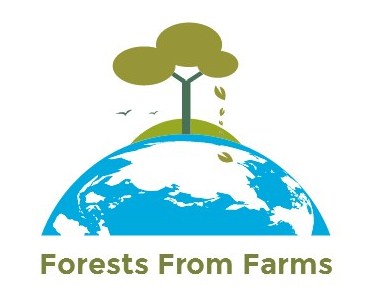WELCOME TO FORESTS FROM FARMS
Combat Climate Change Together by Transforming
Farms into Forests by Rewilding
"Brush and comb gardens are dead compared to living in the bush.
When the land is left wild, it is full of wonder."
Translate This Page
WHY AN ASSOCIATION FORESTS FROM FARMS?
Climate change is happening right now and it won't get any better unless we not only stop emitting greenhouse gases but also remove the excess that's already in the atmosphere and oceans. The purpose of Forests from Farms is to do both at once.
One of the biggest contributors of the emissions that cause climate change is agriculture, especially the raising of livestock. Partly it's the direct emissions of greenhouse gases such as methane, oxides of nitrogen and carbon dioxide, but another component is change of land use. According to some research changing cropland to pasture can increase the amount of carbon stored in the soil by 19 %, while creating secondary forest can increase it by over 50%.
Creating a forest from cropland also removes carbon dioxide from the atmosphere and stores it in the trees.
Other reasons to create and protect forests: wildlife habitat, reduced soil erosion, quality of life and the capture and release of water, nutrients and sediments.
Currently land is seen as an asset or an investment and the owner wants to earn money from it. It's not easy to convince these people to leave the land idle as it will no longer make them any money.
Our objective is to buy cropland and leave it alone so that it reverts to nature. Initially we will allow it to revert to grassland with native shrubs and bushes, but as more funds and resources become available we intend to plant native trees, especially those that provide nuts and fruit.
Once they become established, these edible forest areas will be made open to the public so that they can learn about the importance of the natural world in providing a habitable environment.
They will also be able to pick the fruits and nuts if they wish.
How the process of putting carbon back into the soil works is explained clearly in this little video :
When you become a member of Forests From Farms you financially help the association to buy farmland and convert it into forests. It is not only a way of offsetting your greenhouse gas emissions, but also helps to restore nature and help our native wildlife to flourish.
What are the benefits of turning farmland into forests?
Allowing cropland to revert to wild, whether as grassland or forest or anything in between has many advantages. Water retention is improved, soil erosion is reduced and soil quality is improved. Without interference from Man and with freedom from pesticides and herbicides, wildlife returns to the area and biodiversity is improved.
In addition, carbon dioxide, a major greenhouse gas is removed from the atmosphere and sequested, not only in plants, but also in the soil. It is almost impossible to state with certainty how much carbon dioxide can be removed for a given area of land. It depends on the rainfall, the plants, the soil structure and composition etc. Studies have shown that it can range from about 360 to 3,600 kgCO2/ha per year in humid and cool climates. (1)
Carbon dioxide is also removed from the atmosphere by plants. We plan on planting trees that will not be harvested commercially so we expect them to live to a ripe old age. The amount of carbon sequestered depends on the species of tree and its age. We intend to plant a mix of trees with different useful functions, such as producing fruit or nuts, fixing nitrogen or being suitable for coppicing. The calculator here is intended for use in urban and suburban settings, but we think that it is also suitable for our case where we don't intend to have a rigid plantation. Using it's figures, we can see that, for example, over a period of fifty years a walnut tree will have extracted nearly 7 tonnes of carbon dioxide from the atmosphere and sequestered it. That's about the yearly carbon footprint of the average European or a bit less than half of the average citizen of the United States. (2)
How much space is required?
Obviously not all trees that get planted survive. According to the calculator only about 20% survive to the age of fifty. So for the average European to offset their emissions requires the planting of at least 5 such trees per year. Forestry guides estimate that such a tree requires about 50 square metres at maturity. However, because in the long term only one is expected to survive, then the amount of space required to offset one year's carbon footprint is the space taken up by just one tree. In practice, as we don't know which trees will survive, five will be planted at suitable distances and any that die will be replaced.
(1) http://cdn2.sustainabilitylabs.org/ecosystem-restoration/wp-content/uploads/2015/10/Soil-Carbon-Sequestration-Impacts.pdf
(2) http://data.worldbank.org/indicator/EN.ATM.CO2E.PC
Please watch this little video of one of the properties of Forests From Farms




